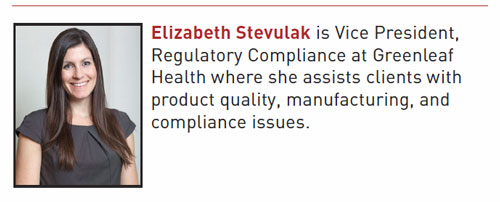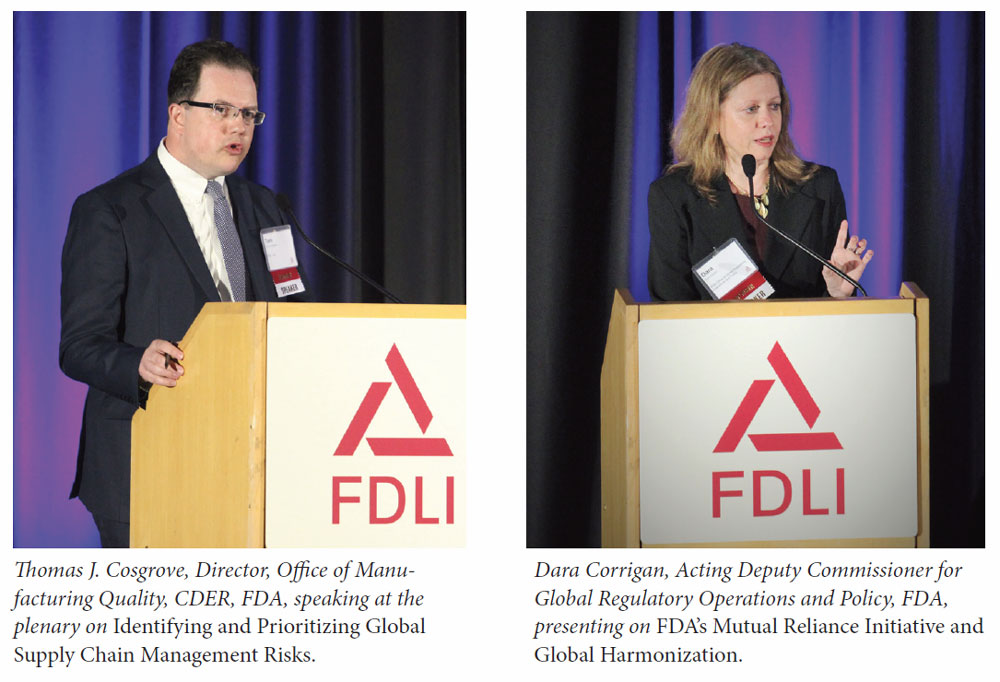
FDA Inspections: The Changing Landscape
by Elizabeth Stevulak
The Food and Drug Administration (FDA)’s team of facility inspectors report to the Office of Regulatory Affairs (ORA). ORA oversees all field activities within FDA including inspection of regulated products and manufacturing facilities, sample analysis, and reviews of imported products. As part of FDA’s Office of Global Regulatory Operations and Policy (GO), ORA works closely with counterparts in foreign countries. The inspectorate in the field has historically consisted of offices scattered around the US, and the rest of the world, with teams that oversee FDA regulated product manufacturing in those designated geographic areas.
 Two initiatives are changing the way FDA approaches and conducts inspections—both domestically and abroad. The first of these two is the realignment of ORA. This initiative is focused on the improvement of overall efficiency for domestic inspections, some foreign inspections, and the knowledge of inspectors. The second initiative is focused on harmonization with European Union (EU) member countries to lower the burden of inspections on both parties by sharing and relying on information gathered by the other party within international inspections.
Two initiatives are changing the way FDA approaches and conducts inspections—both domestically and abroad. The first of these two is the realignment of ORA. This initiative is focused on the improvement of overall efficiency for domestic inspections, some foreign inspections, and the knowledge of inspectors. The second initiative is focused on harmonization with European Union (EU) member countries to lower the burden of inspections on both parties by sharing and relying on information gathered by the other party within international inspections.
Realignment has been carefully planned and was launched on May 15, 2017. Former FDA Commissioner Margaret Hamburg first tasked a group of senior staff at FDA, known as the Program Alignment Group (PAG), to develop a plan to modify the processes in which ORA functions to better address regulatory challenges. When this project was announced Hamburg explained the challenges facing ORA, including “the increasing breadth and complexity of FDA’s mandate; the impact of globalization on the food and medical product supply chains; and the ongoing trend of rapid scientific innovation and increased biomedical discovery.”1
The goals of this effort as communicated in 2013, and again in 2014, were to establish senior executive program directors in ORA, jointly develop new inspection approaches with the product centers, invest in expanded training across ORA and the centers for investigators, compliance officers and managers, expand compliance tools, optimize FDA laboratories, and create specialized investigators, compliance officers and first-line managers for specific issues like bioresearch monitoring and tobacco.2
The Program Realignment effort will strengthen the structure of ORA and the way inspections are conducted by moving from a geographic structure to a commodity-based structure. Specifically, the five regional field offices under ORA will be replaced with seven commodity-based or operations-aligned offices. These divisions include the Office of Bioresearch Monitoring Operations (OBIMO), Office of Biological Products Operation (OBPO), Office of Medical Device and Radiological Health Operations (OMDRHO), Office of Pharmaceutical Quality Operations (OPQO), Office of Human and Animal Food Operations, (OHAFO), Office of Enforcement and Import Operations (OEIO), and the Tobacco Operations Program. Additionally, each office, with the exception of the Tobacco Operations Program, is broken up into two or more regional divisions.3 For example, the OPQO is comprised of six divisions, including a division of Foreign Pharmaceutical Quality Inspections.4 These offices will be supported by the 20 existing district offices. Field laboratories will also be aligned by commodity. The May 15 launch introduced the new commodity-based divisions, which will replace the central, pacific, northeast, southeast, and southwest offices. While the structure is being put into place, it will likely take some time to fully implement across the country, especially given the training and education required to bring inspectors up to speed on product-specific inspections.
What does this shift mean for your company or clients? This change will ensure more consistent communication within, and between, FDA offices leading to better alignment on policies and decisions. There is great potential for more efficient inspections with knowledgeable and specialized inspectors. One hope, as expressed by Jeff Shuren, Director of the Center for Devices and Radiological Health (CDRH), is that inspections become more timely by revisiting standard operating procedures (SOPs).5 Pre-realignment inspectors were generally required to oversee multiple product areas in a certain region, requiring a great deal of specialization that many did not always possess. The goal is that inspections will become easier for both inspectors who have been trained on a specific commodity area and for manufacturers who may have experienced disjointed and lengthy inspections in the past. While FDA works out the details of this realignment, we can expect a fair number of questions. Just like moving a house or an office, some things are bound to be lost in the shuffle. Communication is key to ensuring pending issues don’t fall through the cracks. However, unlike an office or house move, this process is going to take a while. Look for ongoing development and training as field offices are realigned over the next few years.
The second development in the world of FDA inspections focuses specifically on the pharmaceutical industry. FDA currently inspects facilities around the world to ensure pharmaceutical drugs and drug components produced in different countries follow the standards required for sale and distribution in the US. However, FDA simply does not possess the resources to inspect the entire global supply chain. Many foreign inspections have raised eyebrows in recent years due to breaches in current good manufacturing practices (cGMPs). These breaches have led to FDA’s issuance of warning letters, which require further inspection. International inspections are costly and time consuming, which has put pressure on resources and international inspectors. That burden has increased in the last decade as the number of drug manufacturing facilities has increased 28% in the European Union (EU), 66% in India, and 66% in China from 2011 to 2016.6

In 2016, there were 1224 drug facilities in the European Union and FDA inspected 32% of them. Five percent of those inspected facilities led to an Official Action Indicated classification. FDA international inspectors also visited 21% of China’s 754 drug facilities and 23% of India’s 722 drug facilities. The US FDA is not the only entity to inspect these facilities. Other countries are also expending resources to inspect facilities that provide products to their citizens, and thus the idea of exchanging information arose, and mutual reliance on one of the inspections conducted on a facility.
The 2012 Food and Drug Administration Safety and Innovation Act (FDASIA) gave FDA the authority to recognize inspections conducted by foreign regulatory authorities, once FDA has determined that a country is capable of conducting inspections that meet U.S. requirements.7
In 2014, the US and the EU began evaluation of a Mutual Recognition Agreement that would allow mutual reliance on one another’s inspection information for GMP surveillance inspections, and some pre-approval inspections.8 This required review of regulatory and procedural framework for inspections. This collaboration was successful, and on January 19, 2017, the EU and US signed an amendment to the Pharmaceutical Annex to the 1998 US-EU Mutual Reliance Agreement.9 The scope of this agreement includes a majority of drug products; however, certain products like vaccines and veterinary products will be reevaluated in the future. The agreement also includes surveillances and under certain conditions, pre-approval inspections of marketed human drug facilities within the US and EU.10
The timeline for implementing this agreement moving forward was presented at FDLI’s Annual Conference on May 5, 2017 by Dara Corrigan, Acting Deputy Commissioner for Global Regulatory Operations and Policy. The agreement includes capability assessments that FDA will complete for all 28 EU member countries. These capability assessments are done country by country in the EU, since the EU itself has differing inspection standards among its member countries. This is important since the EU inspection model is for two inspectors, each from a different member country, to inspect a facility. As of November 2017, eight joint assessments will have been completed, and information sharing will move forward.
What if one of the member countries assessed in the future fails to meet the standard set by the US? Corrigan stated that FDA knows there is a potential that one or more countries in the EU would fail to meet the criteria for capability.11 If this happens, FDA has built in a process to let that country know what it needs to meet expectations, and it would be that country’s responsibility to correct the problems, if possible, and request a reassessment. One country’s deficiency will not discount the agreement for reliance with other countries in the EU.
As of November 2017, FDA will be able to rely on inspection reports from eight EU member countries that have been recognized as capable of inspecting to US standards. The overall goal of this mutual reliance agreement is to save and leverage inspectional resources in the EU by using reliable inspection data from foreign sources. By doing so, FDA will then be able to dedicate more inspectional resources to other regions of the world, like India and China. Information sharing not only saves resources, but it also will allow FDA to focus on a risk-based approach to inspections.
The EU has promised to complete its capability assessment of the US by July 2017 and the US has committed to completing the EU member country assessments by July 2019.
- FDA’s Program Alignment Addresses New Regulatory Challenges, Margaret A. Hamburg, M.D., FDA Voice, https://blogs.fda.gov/fdavoice/index.php/2014/10/fdas-program-alignment-addresses-new-regulatory-challenges/
- Id.
- FDA Launches New ORA Structure to Align Inspections with Expertise, by Michael Mezher, May 15, 2017, http://www.raps.org/Regulatory-Focus/News/2017/03/28/27207/FDA-Office-of-Regulatory-Affairs-Realignment-to-Begin-in-May/.
- FDA Aligns New Pharmaceutical Inspectorate Into Six Divisions, by Bowman Cox, The Pink Sheet, https://pink.pharmamedtechbi.com/ps120652/FDA-Aligns-New-Pharmaceutical-Inspectorate-Into-Six-Divisions.
- FDA Office of Regulatory Affairs Realignment to Begin in May, by Michael Mezher, March 28, 2017, http://www.raps.org/Regulatory-Focus/News/2017/03/28/27207/FDA-Office-of-Regulatory-Affairs-Realignment-to-Begin-in-May/.
- The Mutual Reliance Initiative: A New World for Pharmaceutical Inspections, Presentation by Dara Corrigan, FDLI Annual Conference May 5, 2017.
- Office of Global Regulatory Operations and Policy (GO), US Food and Drug Administration, https://www.fda.gov/AboutFDA/CentersOffices/OfficeofGlobalRegulatoryOperationsandPolicy/default.htm.
- US Reliance on EU Drug Facility Inspections Begins in November, by Sue Sutter, May 5, 2017, The Pink Sheet.
- The Mutual Reliance Initiative: A New World for Pharmaceutical Inspections, Presentation by Dara Corrigan, FDLI Annual Conference May 5, 2017.
- Id.
- Id.
Update Magazine
May/June 2017








